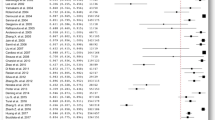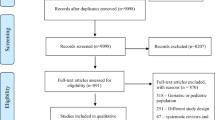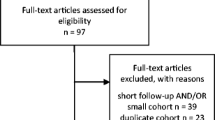Abstract
Background
Vestibular schwannomas (VSs) are benign neoplasms of the Schwann cells of cranial nerve VIII, and treatment of VS typically involves surgical resection. However, tumor recurrence may necessitate reintervention, and secondary treatment modalities include repeat surgical resection or adjuvant radiosurgery. The purpose of this study is to examine the scientific literature in order to determine whether surgical resection or radiosurgery for recurrent VS results in better tumor control, hearing preservation, and preservation of facial nerve function.
Methods
The PubMed, Scopus, Embase, Cochrane, and Web of Science databases were searched for studies reporting on patients undergoing either radiosurgery or repeat surgical resection after primary surgical resection for recurrent VS. Statistical analyses were performed on the compiled data, primarily outcome data involving tumor control, hearing preservation, and preservation of facial nerve function.
Results
We analyzed the data of 15 individual studies involving 359 total patients, and our results reveal that tumor control rates are comparable between adjuvant radiosurgery (91%, CI: 88–94%) and secondary resection (92%, CI 75–98%). However, adjuvant radiosurgery was shown to preserve good facial nerve function better (94%, CI 84–98%) compared to secondary surgical resection (56%, CI 41–69%).
Conclusion
With comparable tumor control rates and better preservation of good facial nerve function, this study suggests that secondary radiosurgery for recurrent VS is associated with both optimal tumor control and preservation of good facial nerve function.



Similar content being viewed by others
References
Ahmad RARL, Sivalingam S, Topsakal V, Russo A, Taibah A, Sanna M (2012) Rate of recurrent vestibular schwannoma after total removal via different surgical approaches. Ann Otol Rhinol Laryngol 121(3):156–161
Ahsan SF, Huq F, Seidman M, Taylor A (2017) Long-term hearing preservation after resection of vestibular schwannoma: a systematic review and meta-analysis. Otol Neurotol 38(10):1505–1511
Arthurs BJ, Fairbanks RK, Demakas JJ, Lamoreaux WT, Giddings NA, Mackay AR et al (2011) A review of treatment modalities for vestibular schwannoma. Neurosurg Rev 34(3):265–279
Badakhshi H, Graf R, Böhmer D, Synowitz M, Wiener E, Budach V (2014) Results for local control and functional outcome after linac-based image-guided stereotactic radiosurgery in 190 patients with vestibular schwannoma. J Radiat Res 55(2):288–292
Bailo M, Boari N, Gagliardi F, Franzin A, Piloni M, Spina A et al (2017) Gamma knife radiosurgery for residual and recurrent vestibular schwannomas after previous surgery: clinical results in a series of 90 patients and review of the literature. World Neurosurgery 98:60–72
Bennett M, Haynes DS (2008) Surgical approaches and complications in the removal of vestibular schwannomas. Neurosurg Clin N Am 19(2):331–343
Boari N, Bailo M, Gagliardi F, Franzin A, Gemma M, del Vecchio A et al (2014) Gamma knife radiosurgery for vestibular schwannoma: clinical results at long-term follow-up in a series of 379 patients. J Neurosurg 121(Suppl):123–142
Fong B, Barkhoudarian G, Pezeshkian P, Parsa AT, Gopen Q, Yang I (2011) The molecular biology and novel treatments of vestibular schwannomas. J Neurosurg 115(5):906–914
Haque R, Wojtasiewicz TJ, Gigante PR, Attiah MA, Huang B, Isaacson SR et al (2011) Efficacy of facial nerve–sparing approach in patients with vestibular schwannomas: clinical article. J Neurosurg 115(5):917–923
Heman-Ackah SE, Cosetti MK, Gupta S, Golfinos JG, Roland JT (2012) Retrosigmoid approach to cerebellopontine angle tumor resection: surgical modifications. Laryngoscope 122(11):2519–2523
Hong B, Krauss JK, Bremer M, Karstens JH, Heissler HE, Nakamura M (2014) Vestibular schwannoma microsurgery for recurrent tumors after radiation therapy or previous surgical resection. Otol Neurotol 35(1):171–181
Hsu P-W, Chang C-N, Lee S-T, Huang Y-C, Chen H-C, Wang C-C et al (2010) Outcomes of 75 patients over 12 years treated for acoustic neuromas with linear accelerator-based radiosurgery. J Clin Neurosci 17(5):556–560
Huang MJ, Kano H, Mousavi SH, Niranjan A, Monaco EA, Arai Y et al (2017) Stereotactic radiosurgery for recurrent vestibular schwannoma after previous resection. J Neurosurg 126(5):1506–1513
Jeltema HR, Bakker NA, Bijl HP, Wagemakers M, Metzemaekers JDM, Dijk JMC v (2015) Near total extirpation of vestibular schwannoma with salvage radiosurgery. Laryngoscope 125(7):1703–1707
Johnson J, Lalwani AK (2012) Chapter 61. Vestibular schwannoma (acoustic neuroma). In: Lalwani AK (ed) Current Diagnosis & Treatment in Otolaryngology—Head & Neck Surgery, 3rd edn. The McGraw-Hill Companies, New York. Retrieved from https://accessmedicine.mhmedical.com/content.aspx?bookid=386§ionid=39944105
Kunert P, Dziedzic T, Nowak A, Czernicki T, Marchel A (2016) Surgery for sporadic vestibular schwannoma. Part I: general outcome and risk of tumor recurrence. Neurol Neurochir Pol 50(2):83–89
Lee H-J, Kim MJ, Koh SH, Chang WS, Moon IS (2017) Comparing outcomes following salvage microsurgery in vestibular schwannoma patients failing gamma-knife radiosurgery or microsurgery. Otol Neurotol 38(9):1339–1344
Louis DN, Ramesh V, Gusella JF (1995) Neuropathology and molecular genetics of neurofibromatosis 2 and related tumors. Brain Pathol 5(2):163–172
Matthies C, Samii M (1997) Management of 1000 vestibular schwannomas (acoustic neuromas): clinical presentation. Neurosurgery 40(1):1–9 discussion 9-10
Mazzoni A, Calabrese V, Moschini L (1996) Residual and recurrent acoustic neuroma in hearing preservation procedures: neuroradiologic and surgical findings. Skull Base Surgery 6(2):105–112
Muzevic D, Legcevic J, Splavski B, Cayé-Thomasen P (2014) Stereotactic radiotherapy for vestibular schwannoma. Cochrane Database Syst Rev (12):CD009897
Perry A, Graffeo CS, Copeland WR, Carlson ML, Neff BA, Driscoll CL et al (2017) Microsurgery for recurrent vestibular schwannoma after previous gross total resection. Otol Neurotol 38(6):882–888
Radwan H, Eisenberg MB, Sandberg Knisely JP, Ghaly MM, Schulder M (2016) Outcomes in patients with vestibular schwannoma after subtotal resection and adjuvant radiosurgery. Stereotact Funct Neurosurg 94(4):216–224
Raftopoulos C, Abu Serieh B, Duprez T, Docquier MA, Guérit JM (2005) Microsurgical results with large vestibular schwannomas with preservation of facial and cochlear nerve function as the primary aim. Acta Neurochir 147(7):697–706
Ramina R, Coelho Neto M, Bordignon KC, Mattei T, Clemente R, Pires Aguiar PH (2007) Treatment of large and giant residual and recurrent vestibular schwannomas. Skull Base 17(2):109–117
Roche P-H, Khalil M, Thomassin J-M (2008) Microsurgical removal of vestibular schwannomas after failed previous microsurgery. Prog Neurol Surg 21:158–162
Samii J, Gerganov VM (2012) Tumors of the cerebellopontine angle. In: Grisold W, Soffietti R (eds) Handbook of Clinical Neurology: Neuro-Oncology,Part II. Elsevier, New York, NY
Samii M, Metwali H, Gerganov V (2016) Microsurgical management of vestibular schwannoma after failed previous surgery. J Neurosurg 125(5):1198–1203
Schriger DL, Altman DG, Vetter JA, Heafner T, Moher D (2010) Forest plots in reports of systematic reviews: a cross-sectional study reviewing current practice. Int J Epidemiol 39(2):421–429
Shelton C (1995) Unilateral acoustic tumors: how often do they recur after translabyrinthine removal? Laryngoscope 105(9 Pt 1):958–966
Sheptak PE, Jannetta PJ (1979) The two-stage excision of huge acoustic neurinomas. J Neurosurg 51(1):37–41
Sun MZ, Oh MC, Safaee M, Kaur G, Parsa AT (2012) Neuroanatomical correlation of the House-Brackmann grading system in the microsurgical treatment of vestibular schwannoma. Neurosurg Focus 33(3):E7
Teo M, Zhang M, Li A, Thompson PA, Tayag AT, Wallach J et al (2016) The outcome of hypofractionated stereotactic radiosurgery for large vestibular schwannomas. World Neurosurg 93:398–409
The PRISMA Statement for Reporting Systematic Reviews and Meta-Analyses of Studies That Evaluate Health Care Interventions: Explanation and Elaboration. (n.d.). Retrieved October 1, 2018, from https://journals.plos.org/plosmedicine/article?id=10.1371/journal.pmed.1000100
Valentino V, Raimondi AJ (1995) Tumour response and morphological changes of acoustic neurinomas after radiosurgery. Acta Neurochir 133(3):157–163
Funding
Prasanth Romiyo is supported by the Tina and Fred Segal Benign Brain Tumor and Skull Base Research Fellowship, AΩA Carolyn L. Kuckein Student Research Fellowship, and Neurosurgery Research and Education Foundation Medical Student Grant. Kevin Ding, John P Sheppard, Methma Udawatta, and Dillon Dejam are supported by the David Geffen Medical Scholarship. H. Westley Phillips is funded by National Institutes of Health/National Cancer Institute Grant R25 NS079198. Isaac Yang is supported by the UCLA Visionary Ball Fund Grant, Eli and Edythe Broad UCLA Center of Regenerative Medicine and Stem Cell Research Scholars in Translational Medicine Program Award, Jason Dessel Memorial Seed Grant, UCLA Honberger Endowment Brain Tumor Research Seed Grant, and Stop Cancer (US) Research Career Development Award.
Author information
Authors and Affiliations
Corresponding author
Ethics declarations
Conflict of interest
The authors declare that they have no conflict of interest.
Ethical approval
This article does not contain any studies with human participants performed by any of the authors.
Additional information
Publisher’s note
Springer Nature remains neutral with regard to jurisdictional claims in published maps and institutional affiliations.
This article is part of the Topical Collection on Brain Tumors
Electronic supplementary material
Figure S1
For serviceable hearing, neither the adjuvant radiosurgery group or the double radiosurgery group showed evidence of publication bias. The same finding held true when the studies were combined (t(6) = 0.692, P = 0.515) as evidenced by this funnel plot. (DOCX 182 kb)
Figure S2
Considering the effect of publication bias on tumor control it was found that the combined adjuvant radiosurgery and double surgery groups did not differ greatly from the tumor control predicted by the fixed effects estimate (t(12) = 0.22, P = 0.83). (DOCX 210 kb)
Rights and permissions
About this article
Cite this article
Romiyo, P., Ng, E., Dejam, D. et al. Radiosurgery treatment is associated with improved facial nerve preservation versus repeat resection in recurrent vestibular schwannomas. Acta Neurochir 161, 1449–1456 (2019). https://doi.org/10.1007/s00701-019-03940-2
Received:
Accepted:
Published:
Issue Date:
DOI: https://doi.org/10.1007/s00701-019-03940-2




